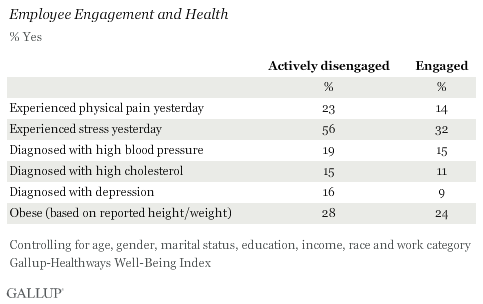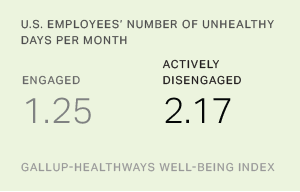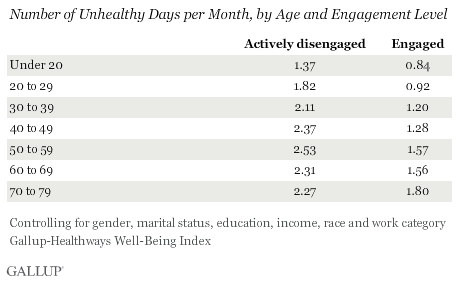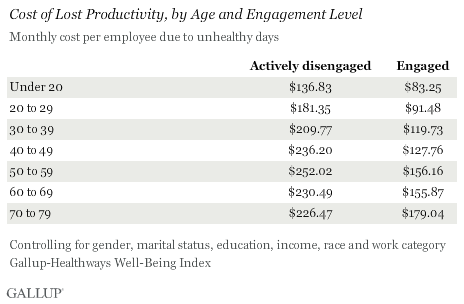- Actively disengaged employees report more unhealthy days
- Engagement may be as important as age for health
- Active disengagement negatively affects productivity
WASHINGTON, D.C. — U.S. employees who are actively disengaged at work are more likely than their engaged peers to say they experience health issues ranging from physical pain to depression
Actively disengaged employees also report more “unhealthy” days, or days in which health issues limited their activity. On a monthly basis, actively disengaged employees have 2.17 unhealthy days, compared with 1.25 unhealthy days for engaged employees.
Gallup categorizes workers’ engagement based on their ratings of key workplace elements that predict important organizational performance outcomes. Engaged employees are involved in, enthusiastic about and committed to their work. Actively disengaged employees are not just unhappy at work; they are busy acting out their unhappiness. Every day, these workers undermine what their engaged coworkers accomplish. Gallup’s extensive research shows that employee engagement strongly connects to business outcomes essential to an organization’s financial success, such as productivity, profitability and customer engagement.
These findings, collected as part of the Gallup Employee Engagement tracking series and Gallup-Sharecare Well-Being Index from January 2014 through September 2015, are statistically controlled for other demographic differences, including respondents’ age. These results do not necessarily indicate that engagement causes better health, but they do show that there is a strong relationship between levels of engagement at work and health.
Health Is as Much About Engagement as It Is About Age
Young workers who are actively disengaged report more unhealthy days than older but engaged employees do. On average, actively disengaged employees aged 20 to 29 have 1.82 unhealthy days per month. This number is higher than it is for engaged employees in all older age groups. For example, engaged employees aged 40 to 49 experience 1.28 unhealthy days per month, and engaged employees aged 50 to 59 experience 1.57 unhealthy days.
Gallup has found similar relationships between work engagement by age and other health issues, including physical pain and stress. While just 16% of engaged employees aged 50 to 59 say they experienced physical pain “yesterday,” 23% of actively disengaged employees aged 30 to 39 say the same. And 33% of engaged employees aged 40 to 49 say they experienced stress yesterday, compared with 63% of actively disengaged employees aged 20 to 29.
Active Disengagement Costs Organizations
As actively disengaged employees experience more unhealthy days than their peers, they end up costing their companies more in lost productivity. A Gallup analysis finds that an engaged worker aged 40 to 49 costs his or her employer $127.76 per month in lost productivity due to unhealthy days, while an actively disengaged worker in the same age range costs $236.20 — an 85% increase.
Bottom Line
Many factors can influence the health of employees, and in some cases, workers with pre-existing health issues may be more likely to miss work and be less engaged. A lack of engagement is not always responsible for a decline in physical or mental health; it is possible that poor health precedes poor engagement.
The data in the current study do not determine the direction of causation. But a previous Gallup study shows that workplace engagement does affect employees’ physiological state to some degree. Researchers examined the daily mood and cortisol (stress hormone) levels of engaged and actively disengaged employees and discovered that engaged employees experience more moments of happiness and interest, and fewer moments of stress and sadness, during the course of their workday.
The researchers found higher levels of morning cortisol for less engaged employees on workdays, with no difference on weekends. These findings suggest that an individual’s work situation affects his or her mood, which then connects to physiological stress.
While the data from the present study are cross-sectional and not longitudinal, research that has looked at the relationship between workplace engagement and health issues over time has found substantial connections between employee perceptions of the work environment and various health problems such as coronary heart disease, inflammation and depression.
As organizations continue to seek ways to reduce healthcare costs, they often turn to wellness programs or incentives to help employees better manage health issues. But they should not discount the role of employee engagement in creating a healthier workforce. Gallup research shows that engaged employees are more likely than actively disengaged employees to participate in wellness programs offered by their organizations. Engagement is a catalyst for higher well-being — it helps put employees in a mindset that encourages them to make healthy decisions.
To achieve the greatest amount of change, leaders should look for ways to integrate purpose, social, financial, community and physical well-being principles through company-sponsored benefits and manager education programs. High engagement and high well-being have an “additive effect,” and when employees achieve both, their organizations benefit immensely. These employees miss fewer days due to illness, are less likely to leave their companies and are more likely to say they are adaptable to change and are performing at an “excellent” level.
Learn more about how the Gallup-Sharecare Well-Being Index works.



